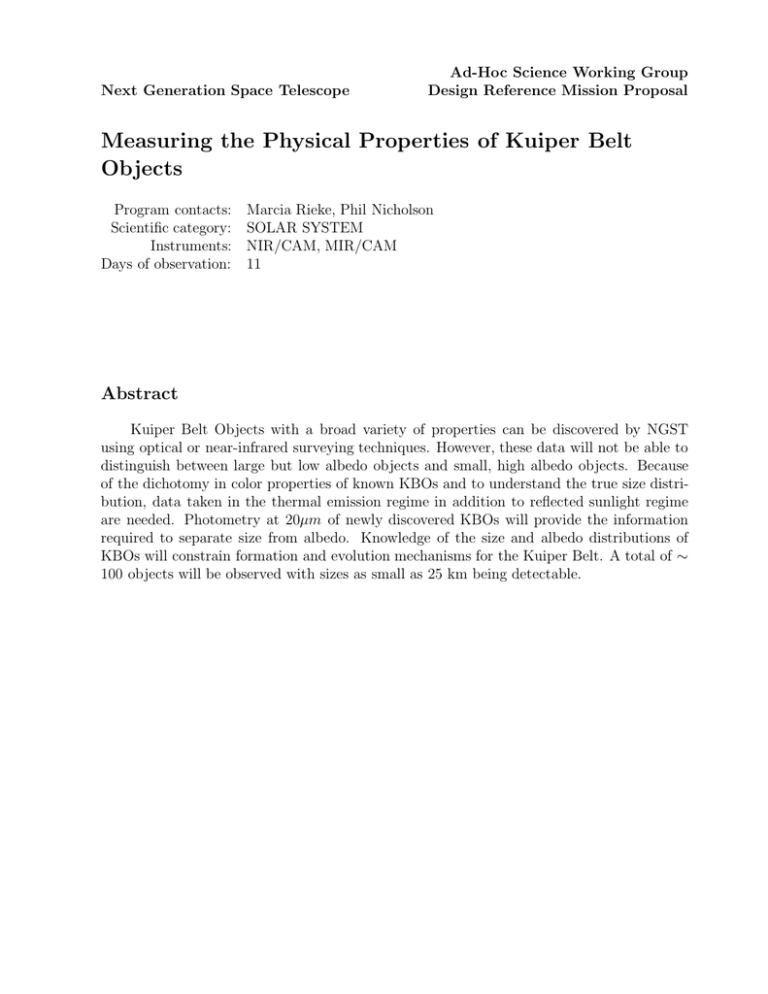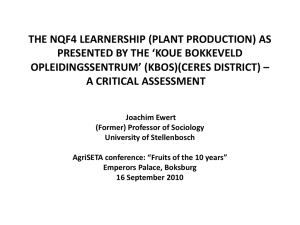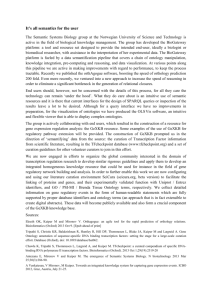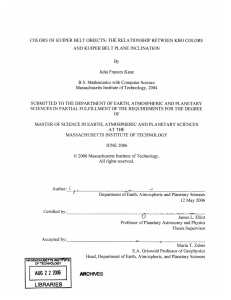Measuring the Physical Properties of Kuiper Belt Objects
advertisement

Next Generation Space Telescope Ad-Hoc Science Working Group Design Reference Mission Proposal Measuring the Physical Properties of Kuiper Belt Objects Program contacts: Scientific category: Instruments: Days of observation: Marcia Rieke, Phil Nicholson SOLAR SYSTEM NIR/CAM, MIR/CAM 11 Abstract Kuiper Belt Objects with a broad variety of properties can be discovered by NGST using optical or near-infrared surveying techniques. However, these data will not be able to distinguish between large but low albedo objects and small, high albedo objects. Because of the dichotomy in color properties of known KBOs and to understand the true size distribution, data taken in the thermal emission regime in addition to reflected sunlight regime are needed. Photometry at 20µm of newly discovered KBOs will provide the information required to separate size from albedo. Knowledge of the size and albedo distributions of KBOs will constrain formation and evolution mechanisms for the Kuiper Belt. A total of ∼ 100 objects will be observed with sizes as small as 25 km being detectable. ASWG DRM Proposal Measuring the Physical Properties of Kuiper Belt Objects Observing Summary: Target NEW KBO NUMBERS 1-100 NEW KBO NUMBERS 1-100 RA Dec 2 KAB 25 Configuration/mode NIR/CAM R3 25 MIR/CAM R3 10 Grand total days 11 Days 1 ASWG DRM Proposal Measuring the Physical Properties of Kuiper Belt Objects Scientific Objectives The Kuiper Belt is a reservoir of small icy and/or rocky bodies presumably leftover from the formation of the solar system which provides a link to the debris disks discovered around other stars. Kuiper Belt Objects (KBOs) may also be the progenitors of short period comets, and may be a source of interplanetary dust. Understanding the character of KBOs will shed light on the processes operating in the circumstellar disks and how such disks may evolve. Such information will be crucial in interpreting the status of disks around other stars and the relationship of such disks to planetary systems. Because of their faintness, few KBOs have any properties measured beyond their orbital shapes and V magnitudes. The few KBOs which have optical and near-infrared colors observed have shown a remarkable range of properties spanning neutral to quite red colors (Jewitt and Luu 1998). If KBOs are icy or ice-coated, they would naively be expected to have red colors because of the formation of dark-colored surface ”tars” caused by cosmicray bombardment. If collisions are common, fresh material would be exposed giving KBOs lighter, more reflective surfaces. Unfortunately neither the time scale for cosmic-ray induced surface changes nor possible collision rates are known to within an order of magnitude, and understanding of the relative importance of these two processes must be determined empirically. If collisions are important, the current size distribution of KBOs may be radically different from the initial distribution with as much as 90% of the original mass being ground down into finer particles (Stern and Colwell 1997). Measuring the distribution of sizes of KBOs thus is very important in understanding the detectablity of Kuiper belt-like structures around other stars where the surface area of material is key. As can be seen from the preceding discussion, collisions may control both the reflectivity and size distribution of KBOs, but disentangling the relative importance of collisions and other processes requires measuring sizes and reflectivities independently. Discovery of KBOs occurs through measuring reflected sunlight at optical to near-infrared wavelengths, and a program for discovery KBOs using NGST will be discussed separately. The discovery data will not be adequate to estimating sizes and albedos because the reflected sunlight is a function both of surface area and the albedo. However, the equilibrium temperature is a function only of the albedo so combining observations of both reflected light and thermal emission can be used to separate surface area from albedo. In the case of NGST, data cannot be taken at the peak of a KBO’s thermal output (which occurs at ∼ 75µm), but data taken from 5 to 35 µm will determine the crossover between reflection and thermal emission and then albedos and sizes can be computed. Based on similar types of studies for asteroids, radii accurate to 10accuracies of 20% should be achievable. Detections of KBOs as small as 25 km in radius (assuming an albedo of 420 µm. References Jewitt, D. and Luu, J. 1998, AJ, 115, 1667 Stern, S. A. and Colwell, J. 1997, AJ, 114, 841 3 ASWG DRM Proposal Measuring the Physical Properties of Kuiper Belt Objects NGST Uniqueness/Relationship to Other Facilities Because NGST will have 3 orders of magnitude better sensitivity at 20µm than any ground based telescope and a factor of 20 better sensitivity than SIRTF, no other platform will have the capability of surveying a large enough number of KBOs to measure size and albedo distributions. SIRTF could measure KBOs at the peak of their output at 70µm, but because of its poorer angular resolution, confusion with background galaxies will vitiate most of the sensitivity gain. Observing Strategy Implicit in this program is the assumption that KBOs will be discovered in significant numbers by other techniques, either by NGST itself or ground based studies. Estimates of the sizes of KBOs found so far range downwards to 100km so adequate numbers of objects should be available. For objects with V magnitudes brighter than ∼ 23, measurements will be made at 5, 10, 20, and 30 µm using filters with R sim4. This suite of wavelengths will define the crossover from reflected to thermal emission thus providing an accurate temperature. Two hours will give 10:1 signal-to-noise in all four filters. For fainter objects, the point at 10 µm takes prohibitive amounts of time and would be dropped. Again, about 2 hours per object would be required to measure 3 wavelengths at 10:1. Special Requirements Maximum tracking blur: 0.1 mas Precursor/Supporting Observations 4







